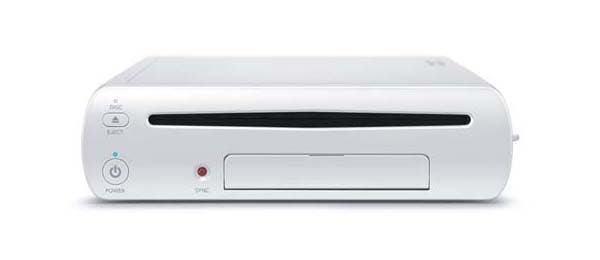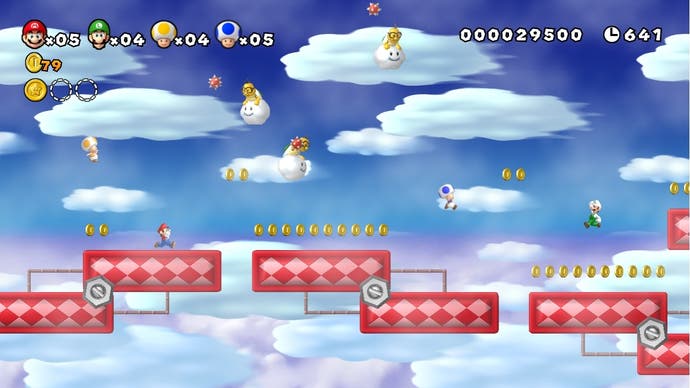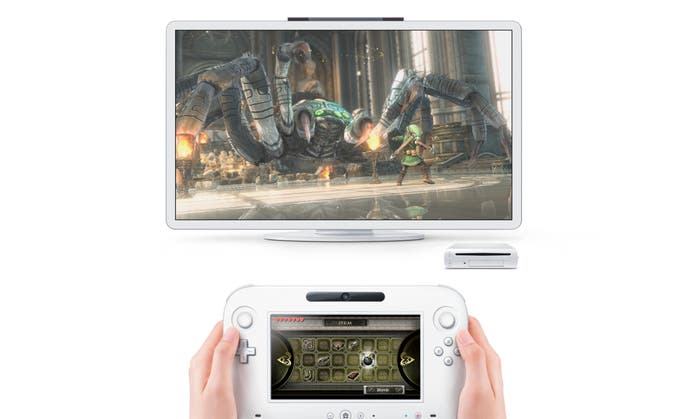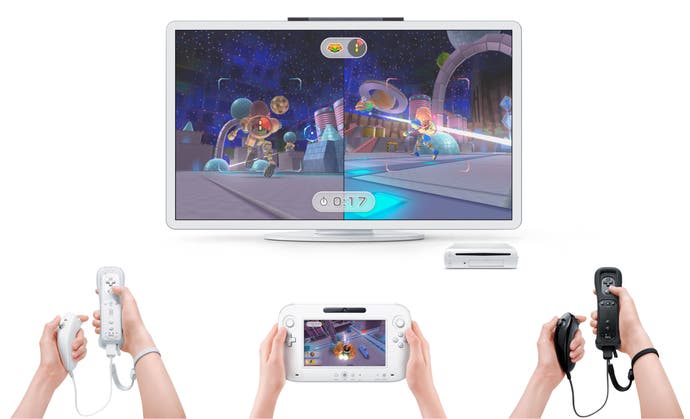In Theory: Nintendo's "Next-Gen" Challenge
Digital Foundry on what to expect from next month's E3 Wii U re-introduction.
Ubisoft and Nintendo would doubtless prefer that one of the biggest news stories of the week never happened. The release of gameplay video showing off the forthcoming Rayman Legends apparently running on Wii U revealed some great stuff: superbly animated 2D visuals spliced expertly with polygon 3D elements, topped off nicely with beautiful cartoon animation and some lovely dynamic lighting. Not only that but we also were treated to a preview of one of Wii U's new features: the tablet controller's Near Field Communication (NFC) wireless tech.
Some say that it was a canny move by Ubi in generating terrific buzz for a title which performed badly last time around - despite Rayman Origins being an excellent release. Others saw the exciting video as a strategically leaked hors d'oeuvre for the Wii U loveliness to come next month at the E3 games convention. In reality, the combination of pre-production controllers and music lifted from the Back to the Future and How to Train Your Dragon movie soundtracks all but confirms that it was indeed an internal Ubisoft presentation that was never meant to see the light of day.
And unfortunately, the gameplay footage we did see gives away very well little about the Wii U's hotly contested "next-gen" credentials, which have dominated headlines recently. Does the Wii U's graphics tech disappoint compared to the Xbox 360? Or, as developers like Gearbox have suggested, does the new hardware allow for improved versions of multi-platform titles?
On the face of it, Wii U's capabilities are fairly self-evident. We've seen Nintendo's game demos, we've seen their tech presentations - from a graphics perspective, this is PS3/360 stuff. Perhaps more obviously, it is telling that company has made no effort whatsoever to suggest that Wii U offers next-generation rendering in any of its marketing - something that would surely be a major selling point that the company would want to get across to the core audience. Yet rumours appear suggesting that Wii U will be twice as powerful as Xbox 360.
The existing body of evidence suggests it won't be (though this particular claim is somewhat lacking in context - 2x what, exactly?) but there's a strong possibility that individual components could see an impressive boost over what is found in current-gen consoles. Similarly, other elements may fall a little short. There's no reason why both the anonymous briefings on the machine's deficiencies and the on-the-record statements can't be equally true. So what exactly should we expect from this year's next-gen entrant?
"Does Wii U graphic tech fall short of the Xbox 360 as rumours have stated? Or can the console exceed current gen performance? In different applications, both situations could be true."

Nintendo doesn't typically talk specs, but the combination of official information released thus far plus a basic knowledge of existing hardware production infrastructure can give us a pretty good idea. Consoles are not built in a vacuum - their parts are fabricated by companies whose facilities and outputs are a matter of public record.
Processing power is driven by Moore's Law, which is typically a factor of the amount of transistors you can cram onto a piece of silicon. The current-gen consoles launched at 90nm (a state-of-the-art fabrication process at the time) and have gradually transitioned to 45nm, being refitted into smaller cases in the process. Nintendo has already revealed that its IBM Power7-derived CPU runs at the same fabrication process as the current PS3 and Xbox 360, and the worldwide shortages in "next-gen" 28nm production suggest that the Wii U's AMD Radeon graphics chip will also be produced at 40nm/45nm - it's the only way to create millions of viable chips in time for a 2012 release, and also opens the opportunity for a die-shrunk cheaper unit to be put into production sooner rather than later.
Combine the realities of chip production with the miniscule dimensions of the Wii U casing (172mm x 45mm x 267mm according to Nintendo's E3 PR - a bit bigger than a current Wii) and we're looking very much at current gen ballpark power - a true "next-gen" upgrade over the current Xbox would be extremely challenging to cool in a box that's so tiny compared even to the slim versions of the PS3 and 360.
Efficiencies in design can make a difference, of course. The Xbox 360 CPU is clocked at 3.2GHz for example, but by Microsoft's own estimates, most games only process around 0.2 instructions per clock - suggesting it's a somewhat poor design that can be improved. GPU design is set to change somewhat going forward with more efficiency in mind (something we've seen with NVIDIA's Kepler tech) but to date, graphics power has been driven very much by Moore's Law, which combined with the rest of the available information suggests that Wii U GPU processing will be very much in the ballpark of the Xbox 360 and PS3.
Some have interpreted the "re-introduction" of the Wii U at this year's E3 as a showcase for a revised spec, with insider sources suggesting that more powerful devkits have been dispatched to developers. To put that into perspective, it's worth noting that designing microprocessors as complex as a CPU or GPU is a hugely involved task that can easily take over a year to complete. Even a GPU like the Wii U's - essentially an offshoot of an existing PC-based product - needs to be designed, fabricated and tested.
"Nintendo isn't interested in the technological arms race that has cost Microsoft and Sony so much. Expect its concept-led philosophy to continue with Wii U."


Unless Nintendo went to the enormous expense of producing two different GPU designs in parallel, the notion of tangibly boosting its existing graphics capabilities seems unlikely. In console design, the core architectures are locked a long, long time in advance - variables that may adjust in terms of the GPU include the amount of ROPs, ALUs and texture units active (some may be disabled so that more defective chips become viable). Clock speeds may be revised, but other than that, there's very little that can be done: consoles are designed as a fixed architecture, after all. The PS3's RSX is a good example here. The core architecture has 28 ALU pipelines, but four are inactive in the final chip. The 16 ROPs had half their number disabled, while memory speed also dropped from 700MHz to 650MHz. Variations in Wii U spec may well come down to Nintendo finalising exactly how many features can be activated while keeping chip yields high, but any changes aren't likely to radically change the capabilities of the unit.
In the face of comments from developers suggesting that the GPU may actually be weaker than the 360's (something we've heard too from a prominent multi-platform developer, back in the Project Café days), Nintendo's recent statement on the power of the machine is telling. The company has never been interested in competing in the technological arms race. In fact, it's probably made more money than Microsoft and Sony combined by staying out of it. It will never win a spec-powered battle of attrition, so it leaves those experiences for others to pursue instead.
The focus is on innovative new gameplay concepts as opposed to cutting-edge rendering techniques, and the emphasis is clearly on the tablet controller in delivering this. We've already seen Nintendo's vision for how the tablet might be used, and we've also been given a glimpse into how it integrates into multiplayer gameplay in combination with existing Wiimotes. However, this week's Rayman Legends leak also illustrates how the tablet can also interact with objects via its Near Field Communication (NFC) tech - something we haven't seen before, and a rich vein of potential.
A concept-orientated focus to the Wii U design does not rule out improvements over current gen consoles in some respects, though. In terms of potential spec boosts, we should be looking for components that have collapsed in price over the last five years - low-hanging fruit for Nintendo, if you like. There's no reason why the Blu-ray derivative drive shouldn't be significantly more refined and faster than the PlayStation 3's. Onboard flash RAM storage (previously rumoured at the 8GB level) could see a boost, especially when we factor in Nintendo's recent announcement of digital delivery for all games day and date with their retail launches.
"Commodities like flash storage and RAM have plummeted in price since the launch of PS3 and Xbox 360 and in Wii U, Nintendo is set to capitalise on these cheap components."


Games should also stand to benefit from more RAM - Wii U should ship with 1GB to 1.5GB of onboard memory depending on which developer leak you wish to believe - far higher than the Xbox 360 and PS3, both locked to 512MB. This may well turn out to be the most useful element for the new machine going forward. Developers typically rank available RAM as one of the most important elements in a console design. This could translate into richer textures and faster loading, for example.
If the overall spec seems conservative for a new console shipping seven years after the launch of the Xbox 360, it's worth factoring in that the world outside of games has changed enormously since the credit-fuelled era of 2005/2006. The economic landscape favours austerity. None of the platform holders will be looking at designs as advanced as the PS3 and Xbox 360 were back in the day; they simply can't afford the burn rate, and neither can their customers stomach steep launch prices. The concept of releasing a games console crammed with state-of-the-art tech, charging £425 for it and still making a loss on every unit - as Sony did with PS3 - simply isn't viable.
So with the upcoming E3 "re-introduction", what do we want to see from Nintendo? Games will always trump specs and tech demos, so we can't wait to see what the internal studios have come up with, especially bearing in mind how wonderful current Wii titles look when rendered in HD via the Dolphin emulator. Great design can always overcome technological barriers and Nintendo's skills in this regard are second to none.
Additionally, bearing in mind how much Nintendo has bet the farm on the tablet controller, it'll be fascinating to see how this new interface is utilised by some of the most creative minds in the games business. From a third party perspective, of course we can't wait to see how Wii U cross-platform releases look, and to what extent newly-revealed E3 titles will accommodate the core gamer.
And yes, crucially, we want to know how much Wii U is going to cost. In a world where Amazon UK sells a brand new 4GB Xbox 360 for just £115, we'd really like to see Wii U released at £180/$250 - exactly what its predecessor launched at back in 2006, and a fundamental element in ensuring that the system enjoys a storming debut at retail.

